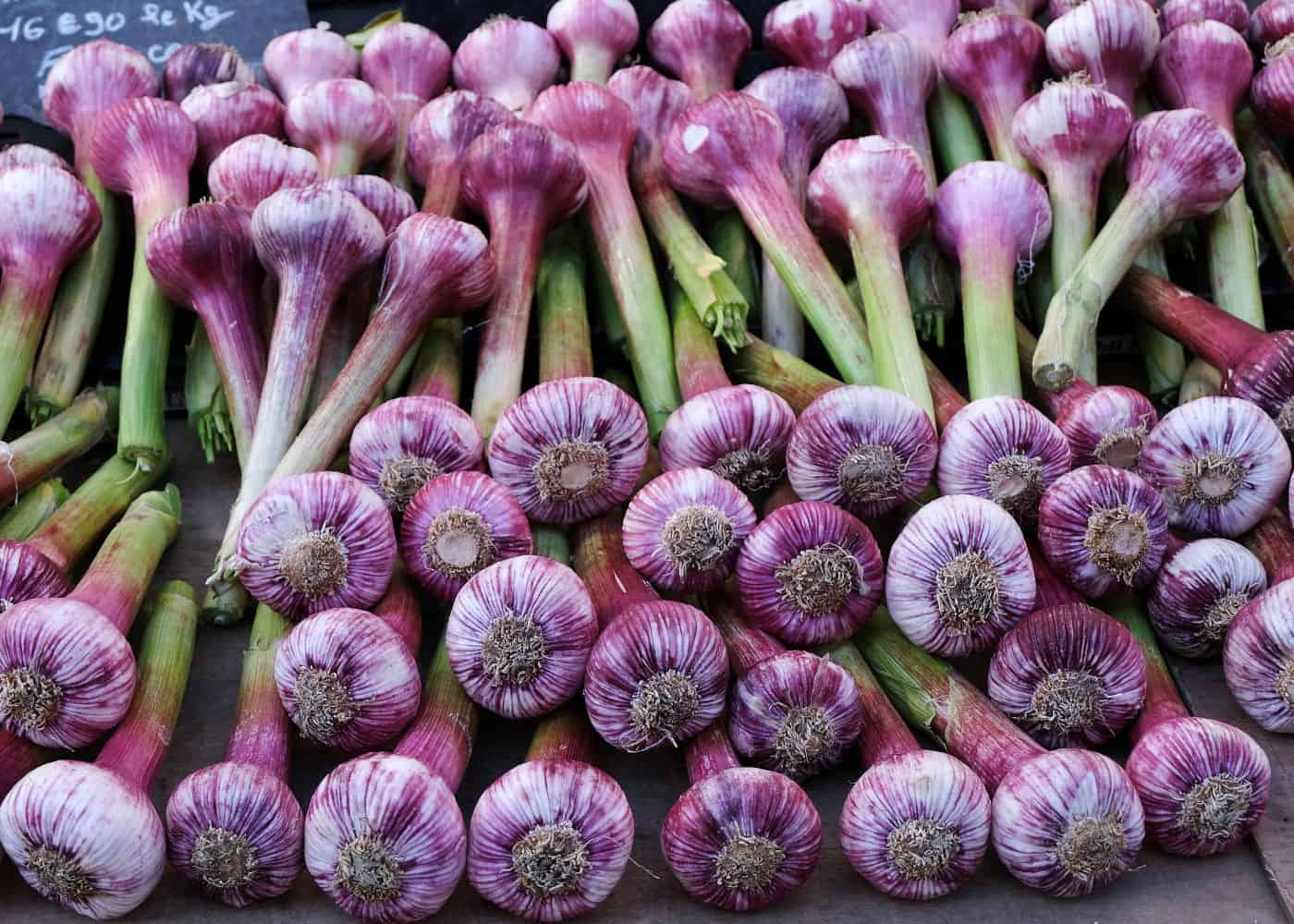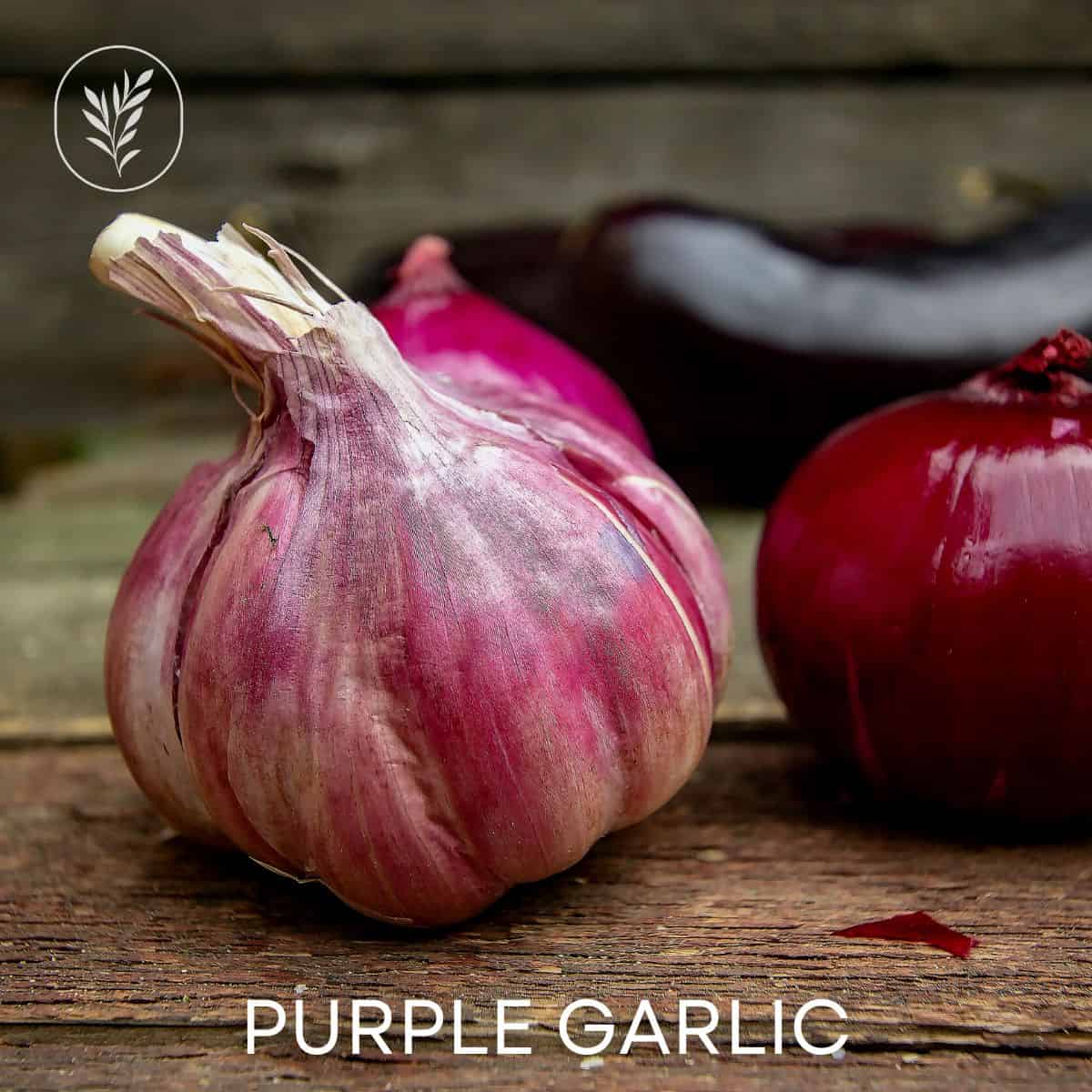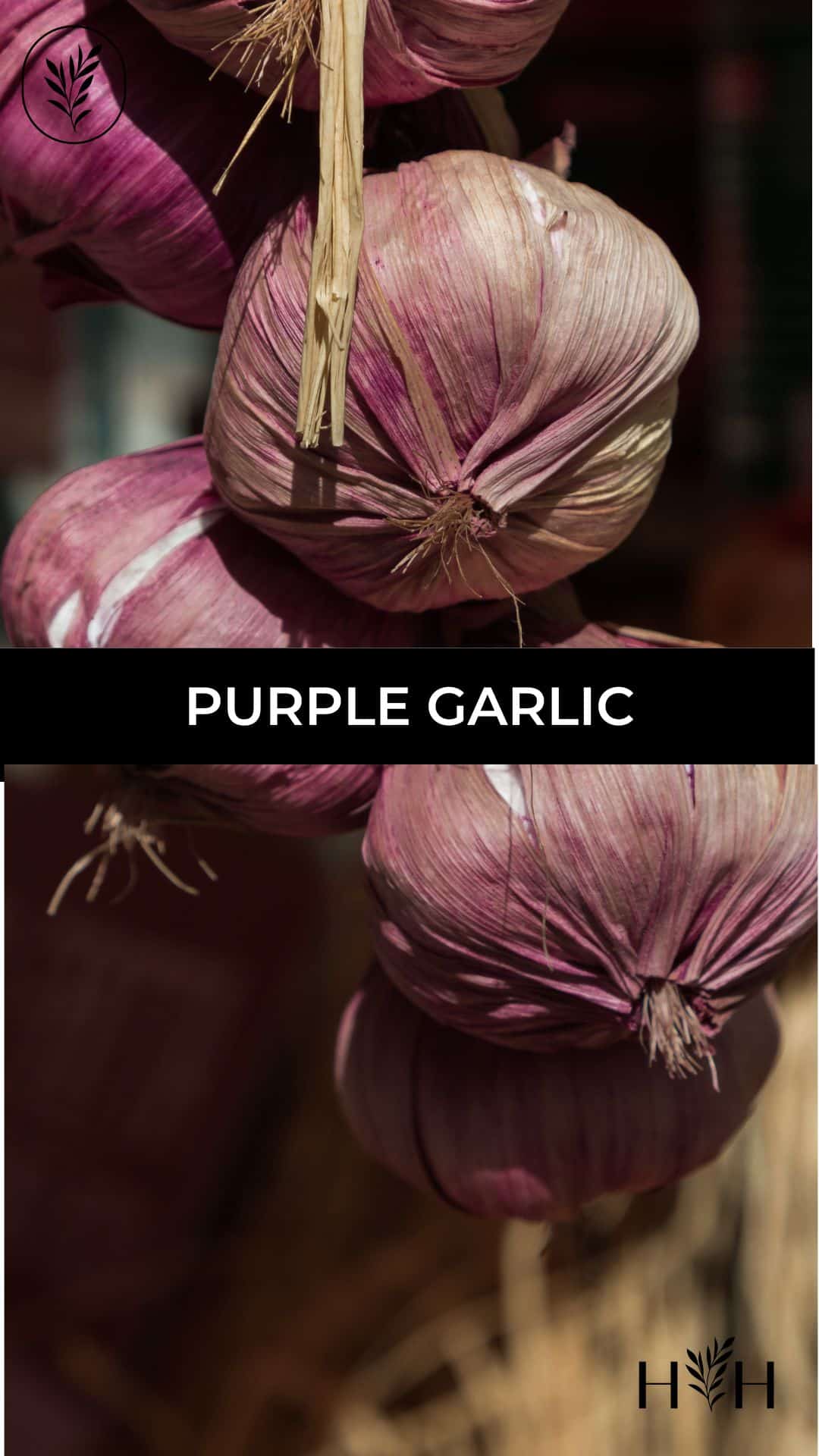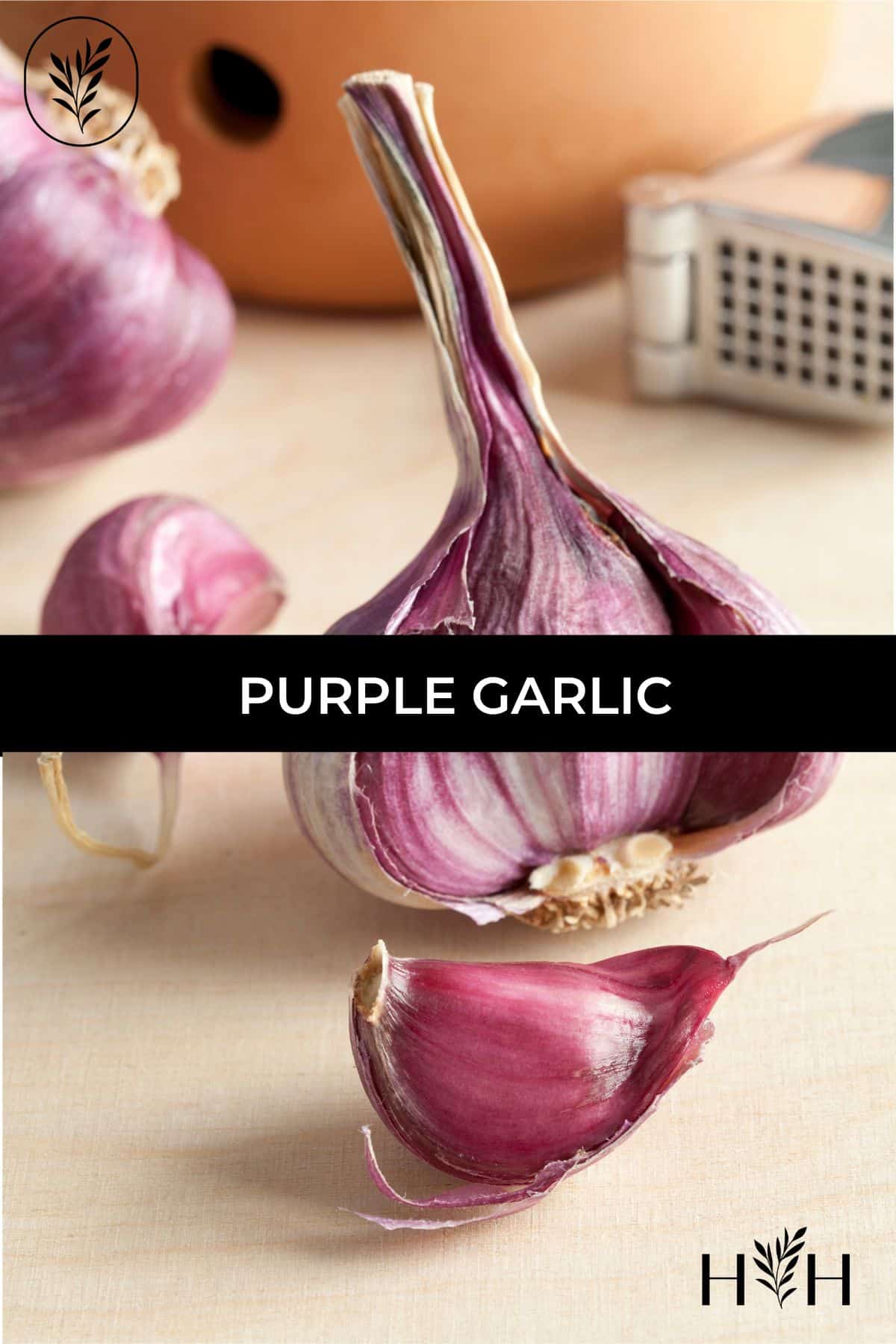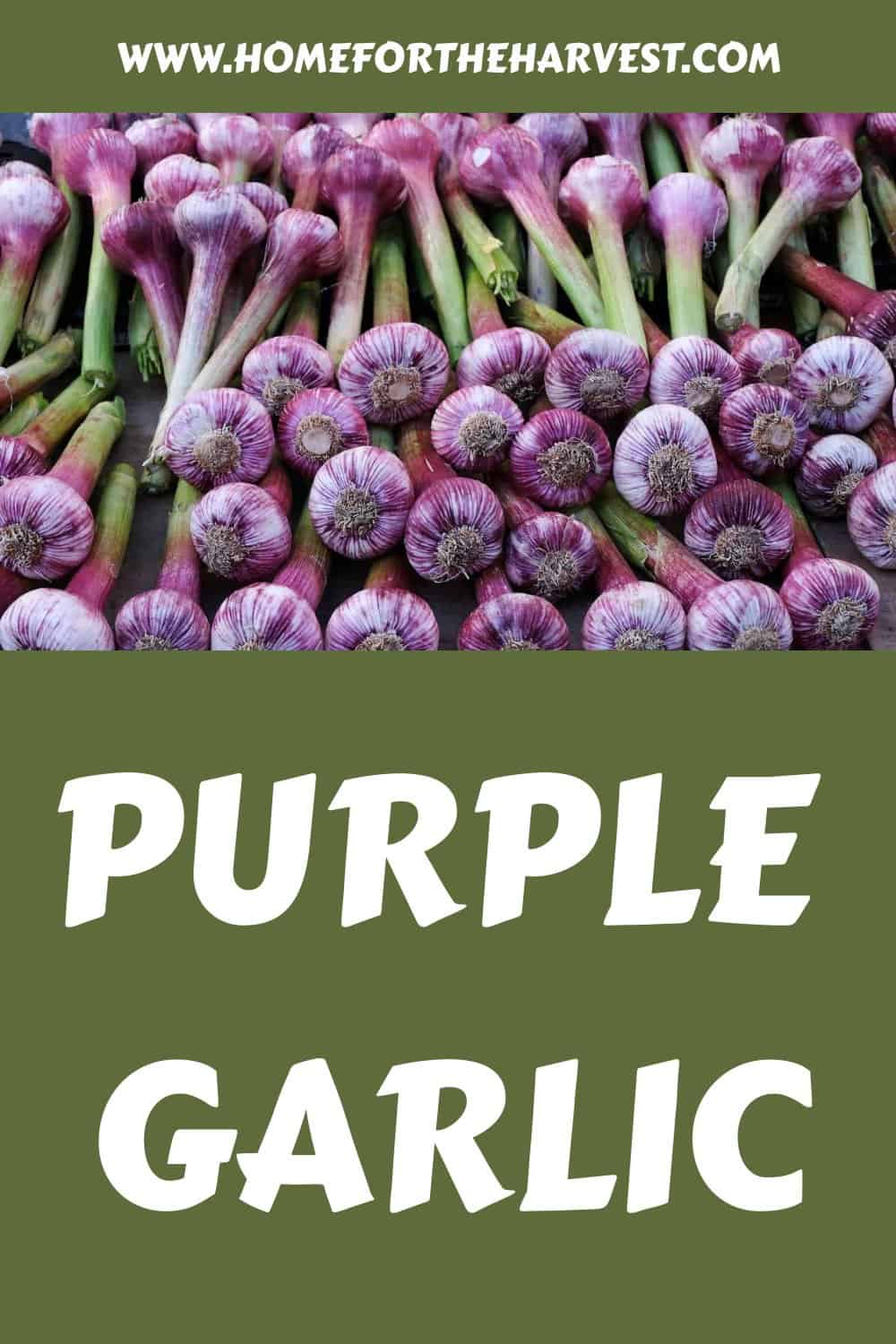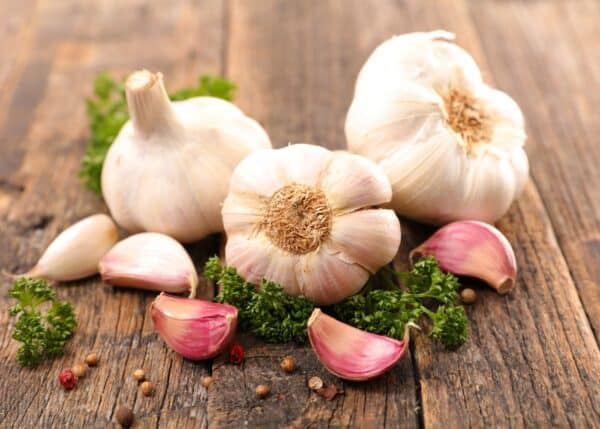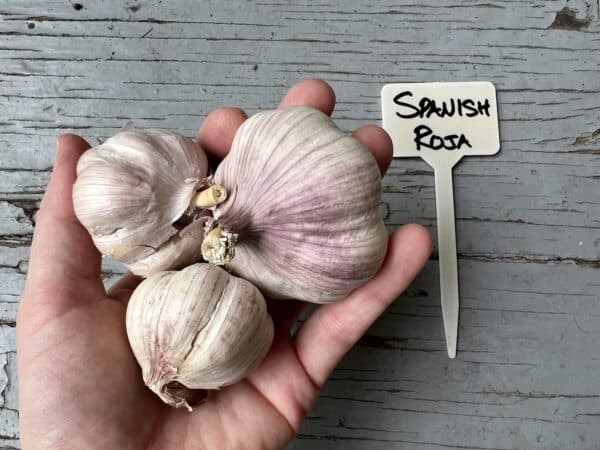Purple garlic is an excellent choice to add a unique twist to your garden and kitchen. This garlic color boasts a vibrant appearance and offers distinctive flavors that can elevate your culinary creations.
Purple garlic refers to varieties of garlic that naturally have purple-colored skin in most growing conditions. The entire bulb may be a lavender color, or the bulb may be white or cream with purple stripes. Some of the most popular purple garlic varieties include ‘Spanish Roja,’ ‘Metechi’ garlic, and ‘Purple Glazer.’
This blog post will explore the different varieties of purple garlic, including popular types like Italian Purple and Chesnok Red. We’ll also provide valuable tips on growing these eye-catching bulbs in your garden for optimal results. Finally, we’ll dive into the world of cooking with purple garlic. So get ready to discover everything about this delightful ingredient and learn how to incorporate it into your everyday meals!
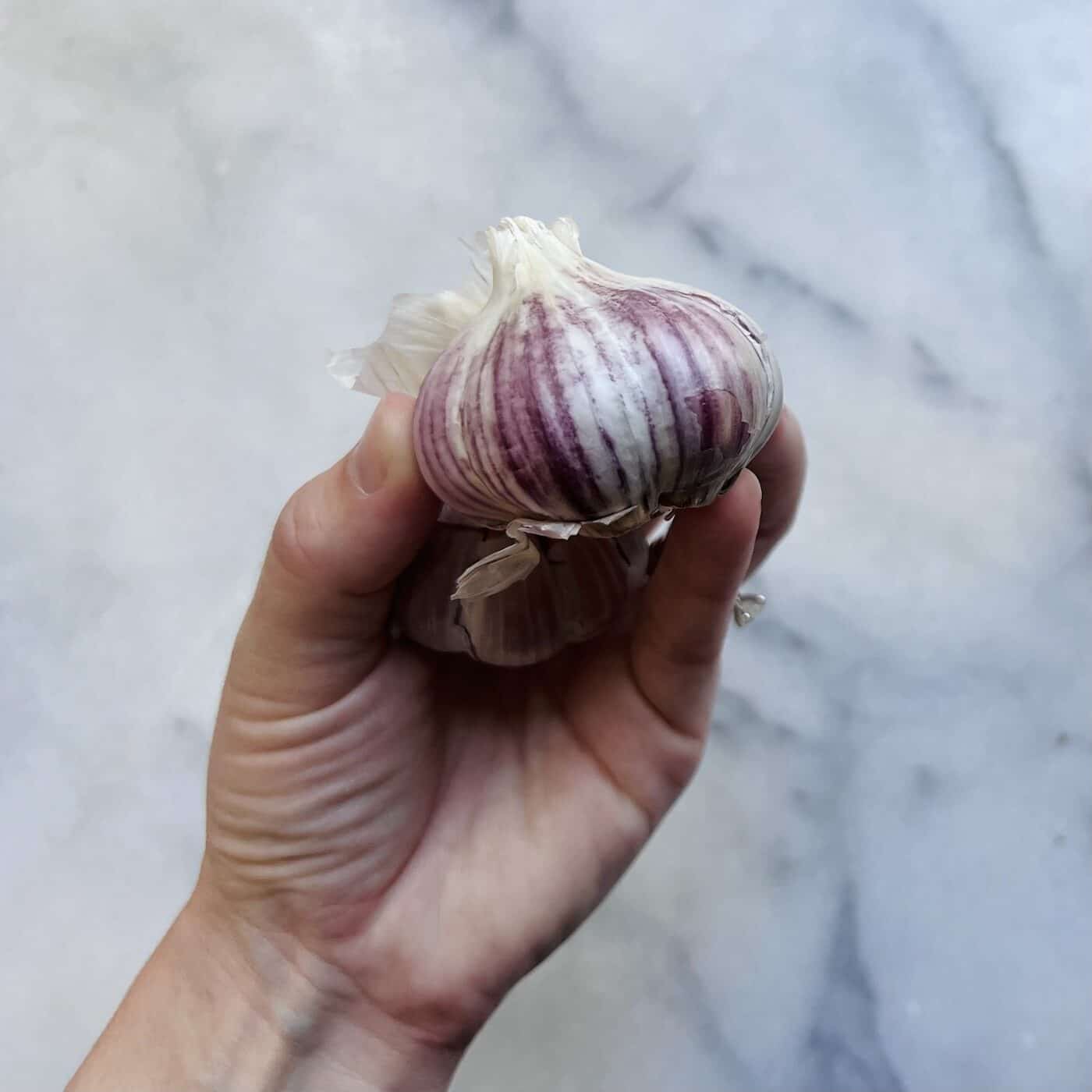
Introduction to purple garlic
If you’re a fan of garlic, then you may have come across purple garlic. Purple garlic refers to certain varieties of this beloved bulb with a distinctive purple hue on its outer skin. Many of these types fall under the category of purple stripe garlic, although not all purple-skinned varieties are classified as such.
The vibrant coloration sets them apart from your typical white garlic, but there’s more to these beauties than just their appearance. In fact, they often boast unique, spicy flavors and other desirable characteristics that make them an excellent addition to the home garden or kitchen pantry.
Here are some basic characteristics of most purple garlic:
- Taste profile: Many people find that purple-colored varieties offer a slightly spicier flavor compared to traditional white grocery store varieties. This makes them ideal for adding an extra kick to dishes like pasta sauces or homemade salsa.
- Milder odor: Some folks also report experiencing less pungent aromas when working with these bulbs compared to other kinds of garlic, which can be a plus for those sensitive to strong smells.
- Purple skin color: The most distinguishing feature of purple-striped garlic is its lovely purplish tint on the papery outer skin that covers each individual clove within the head.
- Clove size: While size can vary depending on factors like growing conditions and specific variety, many types tend to produce larger cloves with fewer overall per head – making peeling and preparation easier.
- Storage: The taste of purple garlic cloves may last longer in storage than other varieties, making them an excellent choice for stocking up and enjoying throughout the year.
In addition to these general characteristics, each variety of purple garlic will have unique traits. For example, the popular Chesnok Red boasts large cloves with a sweet and spicy flavor perfect for roasting or adding to your favorite garlic bread recipe. It’s a breeze to discover a garlic variety that fits your palate and culinary needs, with so many selections available.
Purple garlic is an interesting and unique variety with a deep, rich flavor. Now let’s take a look at the different types of purple garlic available.
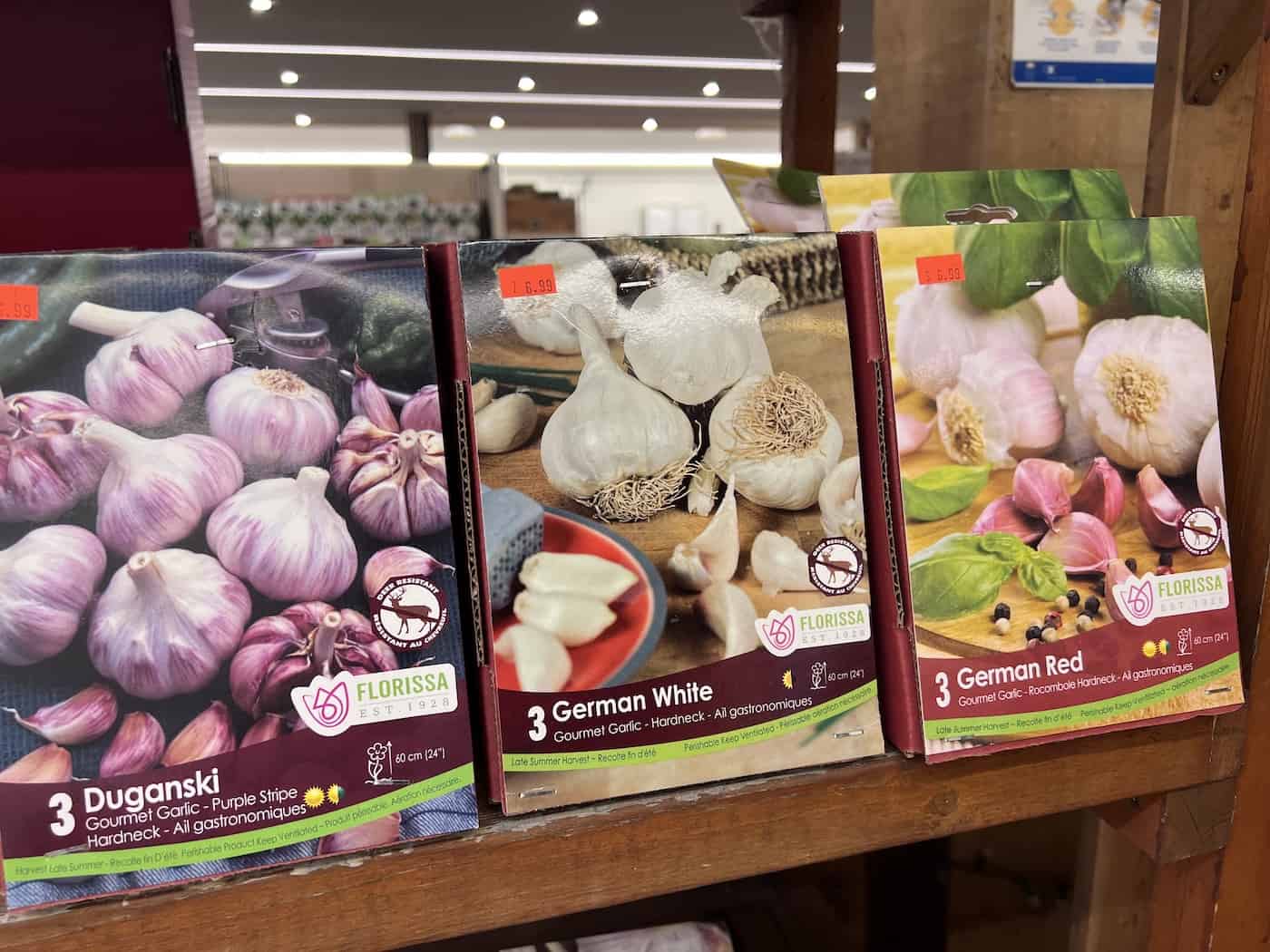
Purple garlic varieties
There are numerous varieties of purple garlic, each with its unique flavor profile and appearance. These types of garlic are known for their beautiful outer skin adorned with vibrant purple stripes. Here are some of the most popular purple garlic varieties available for growing in your garden or buying at the market.
- Metechi: This hardy variety hails from Georgia and is known for its spicy flavor and large cloves. It’s perfect for those who love a robust taste in their dishes. Learn more about Metechi here.
- Bogatyr: Another Georgian variety, Bogatyr has fewer cloves per bulb but packs a punch when it comes to heat level. For those seeking a robust flavor, this garlic is sure to deliver. Discover more about Bogatyr here.
- Russian Red & Russian Purple: As the names suggest, these two varieties originate from Russia and have similar characteristics such as larger cloves wrapped in eye-catching purple-striped skins. They both offer a strong yet mellow flavor ideal for various culinary applications like garlic bread or roasted vegetables.
- Spanish Roja: This Spanish heirloom boasts rich flavors that pair well with olive oil-based dishes like pasta sauces or salad dressings. Its attractive outer skin features deep red-purple hues which make it stand out among other white garlic bulbs on display at markets.
- Duganski: Duganski offers an excellent balance between spiciness and sweetness while maintaining a milder odor. This variety is perfect for those who want to enjoy the taste longer without overpowering their senses. Find out more about Duganski here.
- Mexican Purple, Korean Purple, Yugoslavian, and French: These four varieties share similar characteristics such as large cloves with purple stripes on their outer skin and a spicy flavor profile that adds depth to your dishes.
In addition to these popular options, there are many other lesser-known purple garlic varieties worth exploring, like Chesnok Red or Italian Purple Garlic. No matter which type you choose, adding some vibrant color and unique flavors from these beautiful bulbs will undoubtedly elevate your culinary creations.
Purple garlic varieties offer a unique flavor and color to any dish, making them an interesting addition to the home garden. With proper care and attention, you can grow your own purple garlic in your backyard – let’s look at how.
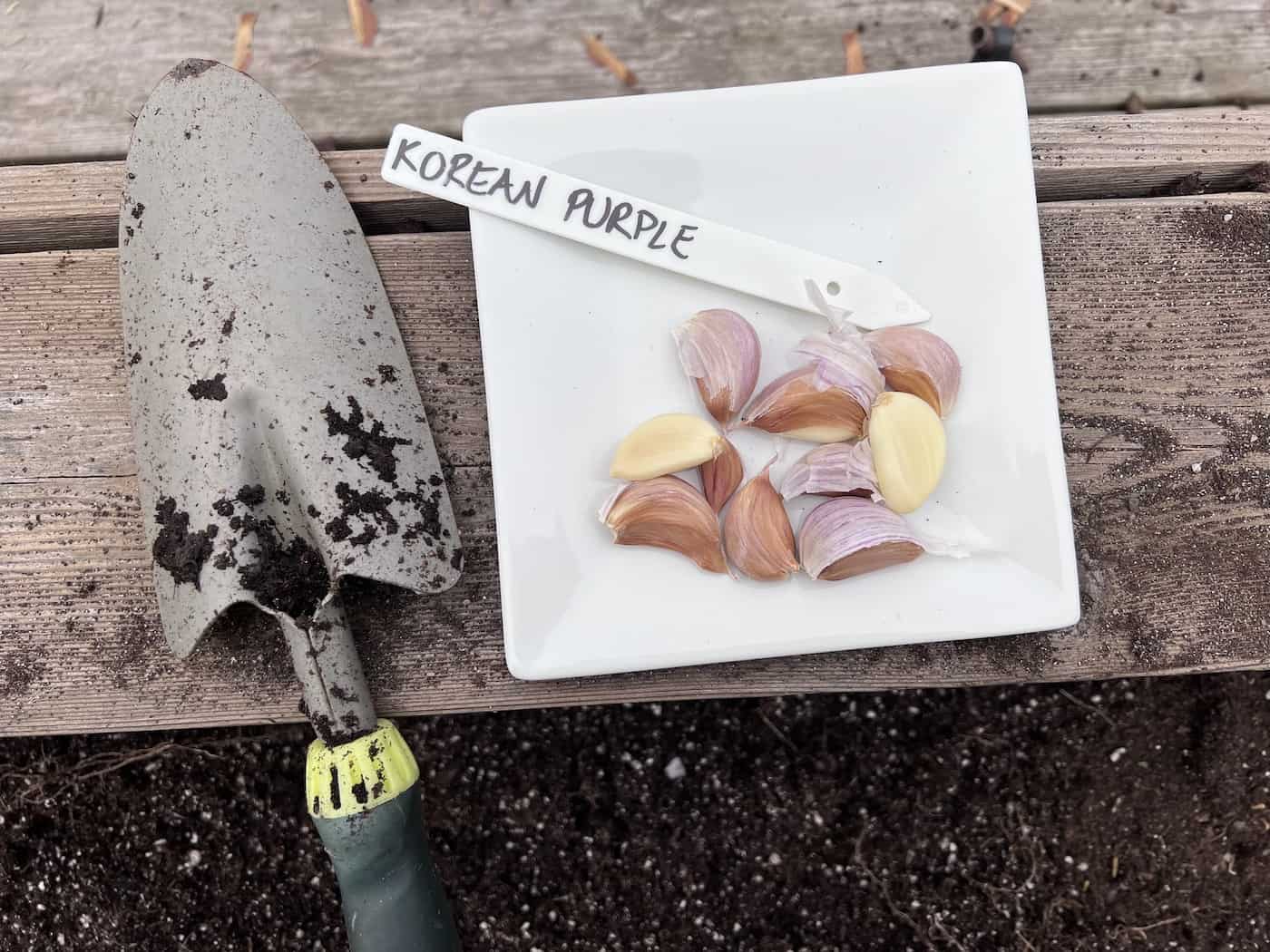
How to grow purple garlic
Growing purple garlic is a rewarding experience for both novice and experienced gardeners. With its vibrant color and unique flavor, it’s no wonder that more people are choosing to grow this delightful variety in their gardens. In this piece, we’ll explore the procedures necessary for successfully cultivating your own crop of purple garlic.
Selecting the right variety
Before planting your garlic bulbs, choosing the right variety for your climate and taste preferences is essential. As mentioned earlier, several purple stripe garlic varieties exist, including Metechi, Bogatyr, Russian Red, Russian Purple, Spanish Roja, Duganski, Mexican Purple, Yugoslavian, French, and Korean Purple, and Chesnok Red.
Each variety has distinct characteristics, such as larger cloves, less pungent odor, spicy flavor, milder taste, and longer storage life. Research each type to find one that best suits your needs.
Planting garlic bulbs
Here are the basics to planting garlic bulbs:
- Choose a sunny location: Like most plants, garlic requires plenty of sunlight to thrive. Select a spot that receives at least six hours of direct sun per day to ensure healthy growth and development.
- Prepare soil: Your soil should be well-draining, fertile, and rich in organic matter. Work compost and aged manure into the existing soil to improve its structure and nutrient content.
- Sow bulbs in fall if possible: In North America, garlic is typically planted either in October-November or April-May. The timing depends on local conditions and preference, but generally, better results are obtained when planted in autumn. This allows the garlic to develop a strong root system before winter sets in, providing a jump start for the following season. Separate individual cloves, keeping the outer skin intact, and plant them pointy end up, about 4 inches deep, spaced 6 inches apart in rows 12 inches wide.
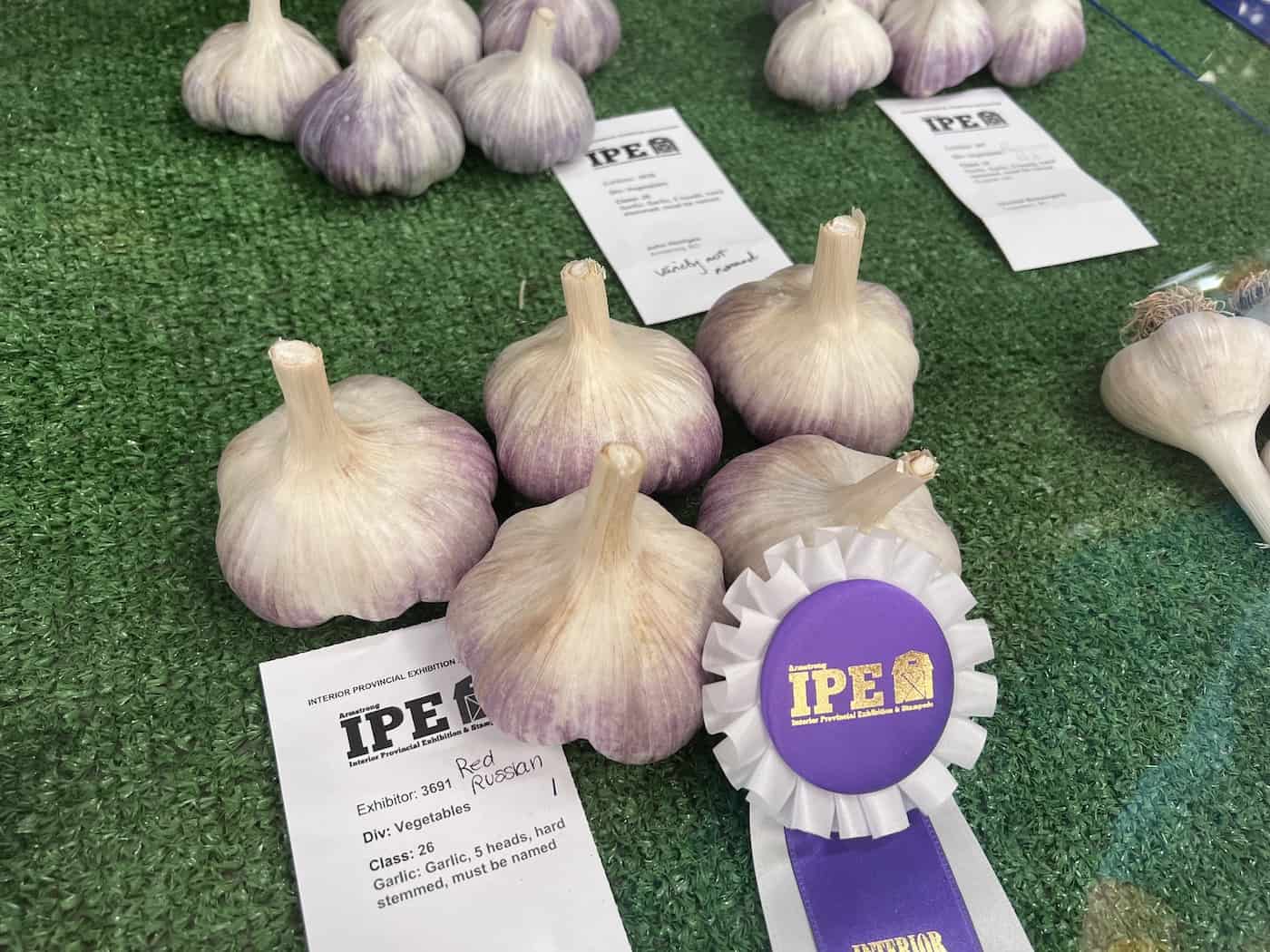
Caring for purple garlic plants
Once your garlic bulbs are in the ground, there are a few simple steps you can take to ensure their success:
- Water regularly: Keep the soil consistently moist but not waterlogged. Overwatering can lead to rot and diseases, while underwatering can stunt growth. Check moisture levels by sticking your finger an inch below the surface. If it feels dry, it’s time to give your plants a drink.
- Mulch: To help conserve moisture, retain warmth, and protect from extreme temperatures, apply a layer of mulch around the base, such as straw, leaves, or grass clippings. This also suppresses weeds that compete for nutrients and space.
- Fertilize: A balanced organic fertilizer applied in early spring and mid-season can boost overall health and productivity. Side dress with additional compost if needed to promote larger bulbs.
Harvesting and storing a garlic crop
Your purple garlic will be ready to harvest when about half of the plant’s leaves have turned brown. Gently loosen the soil around each bulb with a garden fork or trowel, being careful not to damage them.
Once harvested, allow your garlic bulbs to cure in a well-ventilated area out of direct sunlight for two weeks. After curing, trim off any remaining roots and foliage before storing your garlic in a cool, dark place like a pantry or cellar.
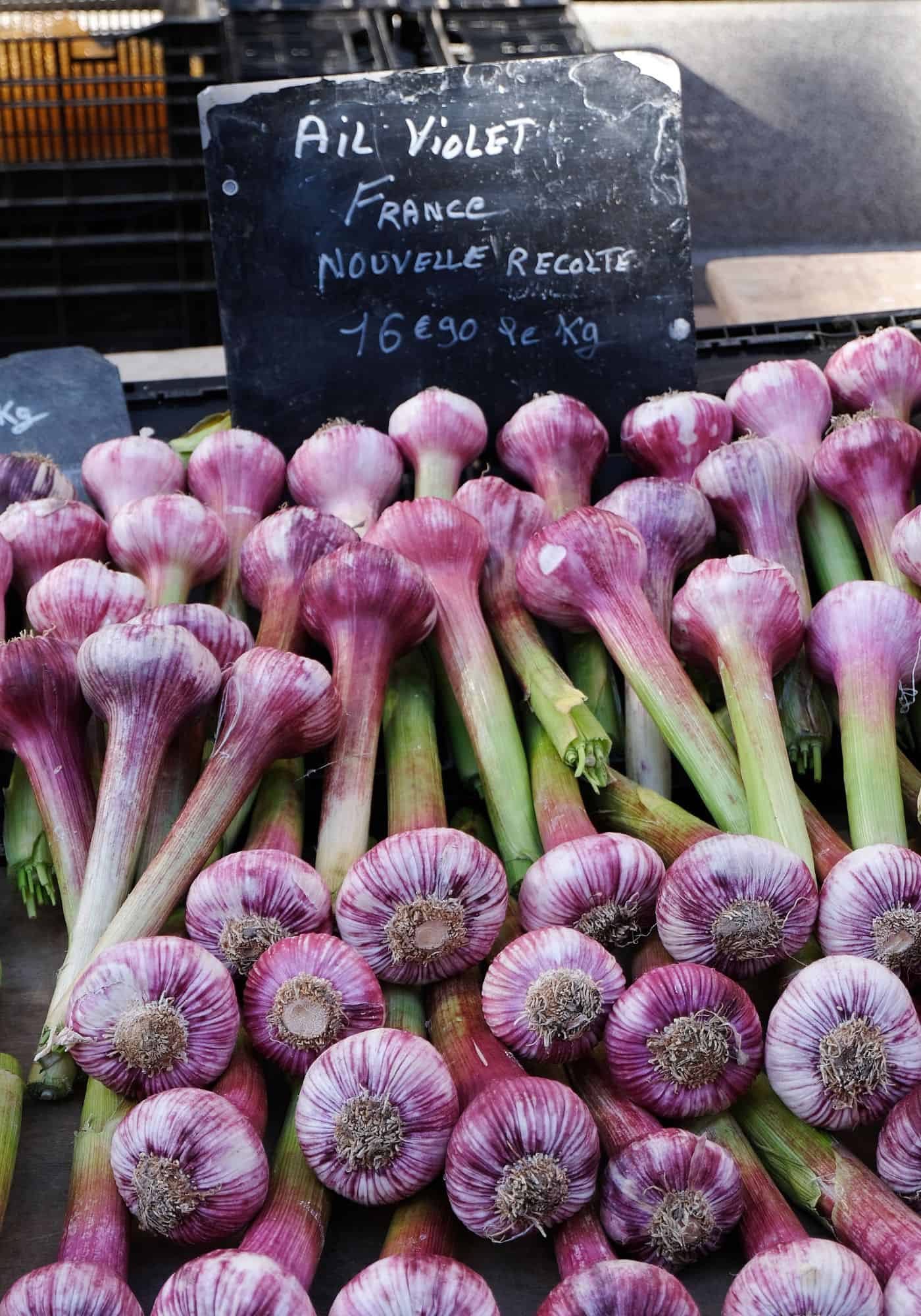
Cooking with purple garlic
Adding purple garlic to your cooking can bring an interesting flavor and color, enhancing your dishes. With its unique color and spicy flavor, this type of garlic adds depth and character to various dishes. In this section, we will explore some delicious ways to incorporate purple garlic into your meals.
Garlic bread with a twist
A classic dish that everyone loves is garlic bread. Try using purple garlic instead of the traditional white variety. Its larger cloves make it easier to work with while providing a more robust taste that pairs well with olive oil and fresh herbs.
Rustic roasted vegetables with purple garlic
The milder odor and taste linger longer, making this an excellent choice for those who prefer fewer cloves in their recipes.
Ingredients:
- Purple garlic bulbs (1 or 2)
- Olive oil (¼ cup)
- Cut up some of your preferred veggies (carrots, spuds, bell peppers, etc.) into sizeable pieces.
Instructions:
- Cut your chosen vegetables into large chunks.
- Toss the vegetables with olive oil and salt & pepper in a large bowl.
- Slice off the top of each purple garlic bulb to expose some of the cloves inside. Place them on a baking sheet along with your prepared veggies.
- Bake at 425°F for approximately thirty minutes until tender and caramelized. Allow to cool slightly before squeezing out individual roasted purple garlic cloves from their outer skin onto your cooked veggies. Enjoy.


